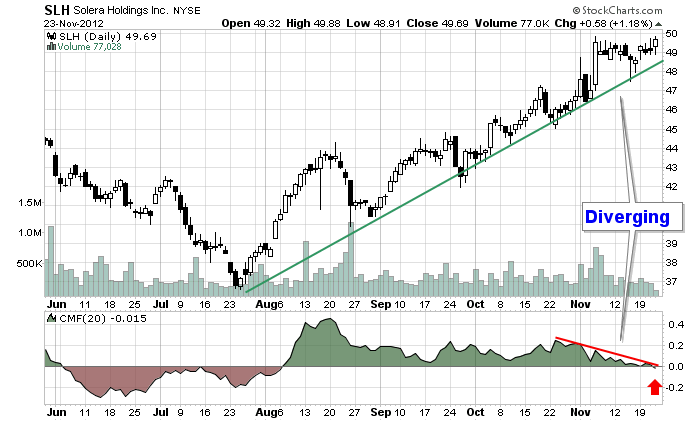Hello Fellow ChartWatchers!
With the market fluctuating significantly right now, the ability to spot trend changes early is critical. Here's an updated re-print of an article I wrote back in 2003 that is still very relevant almost 10 years later. It's about using our Scan Engine to find divergences - situations where one stock is going up and another is going down (or vice versa). Enjoy! - Chip
Scanning for Emerging Divergences
One of the most important technical signals to watch for on any chart is a divergence. Simply stated, a divergence occurs when prices move in one direction (up or down) and an indicator based on those prices moves in the opposite direction.
Divergences signal impending changes in the direction of a stock's price. They come in two flavors - "positive" (AKA "bullish") and "negative" (AKA "bearish"). A positive divergence happens when an indicator starts moving higher after prices have been in a downtrend (a potentially bullish development). A negative divergence occurs when an indicator moves lower while prices are still rising and is a bearish warning signal.
Any oscillating indicator can be used in a divergence study. Popular choices include the MACD, Stochastics, and Wilder's RSI. Many people also use indicators that include volume information - Chaikin's Money Flow for example - since price and volume often diverge at key turning points.
Unfortunately, like many things in the field of technical analysis, spotting divergences while they are still forming can be tricky. The biggest problem is distinguishing between a real divergence and just random "noise" on the chart. Just because a stock moves up for two days while its RSI (for example) declines, it doesn't necessarily mean that a significant divergence has developed - yet.
Often, peak-and-trough analysis is used to find divergences. If, for example, two or more rising troughs appear on the price plot (an uptrend), while two or more decline peaks appear at the same time on the indicator graph (a downtrend), a bearish divergence has been identified. This is how divergence is often taught in textbooks.
As with all forms of peak-and-trough analysis, there are two key problems with this approach. The first problem is that clear trendlines take time to form. The underlying trading opportunity associated with the divergence may be over by the time an unambiguous picture appears on the chart. The second problem is that identifying significant peaks and troughs is often very subjective - one person's significant peak is another person's random spike. For these reasons, peak-and-trough divergence detection is hard to automate (i.e., you can't create scans for it) and it is best used for finding exit signals for existing positions.
Simple divergence scans can be created by selecting (somewhat arbitrarily) a time duration (5 days for example) and seeing if prices have increased by more than a given percentage while the associated indicator has decreased by a different given percentage. Here's a sample scan that uses that technique:
[type = stock] and [close > 1.0] and [volume > 40000] and [close > 5 days ago close * 1.025] and [[[macd line(12,26,9) - 5 days ago macd line(12,26,9)] / AbsVal(5 days ago macd line(12,26,9))] < -0.08 ]
In this example, the price must have increased by at least 2.5% over the past five days, while the MACD value must have decreased by at least 8%. (Note: The advanced scan interface must be used because a function of a function (i.e., AbsVal of the MACD) is needed.)
While this technique is easy to program into a scan engine, its results are hit-and-miss. Many of the charts returned by this kind of scan are not really experiencing a negative divergence. A visual review of all stocks returned by this kind of scan is a necessity.
A different technique is to use the Min and Max functions to ensure that we are at the highest (or lowest) point on the chart for a given time duration. If the stock's price is higher than it's been in the past thirty days (for example) and the indicator is currently lower than it's been during that same period, there's a good change a divergence is occurring. Here's a sample scan that uses that technique:
[type = stock] and [close > 1.0] and [volume > 40000] and [close > yesterday's max(30,close)] and [CMF(20) < yesterday's min(30,CMF(20))]In that example, we're looking for stock that closed higher than the highest close during the previous thirty days and that had a Chaikin Money Flow (CMF) reading that is currently lower than the lowest reading during the previous thirty days. Here's one of the charts that this scan returned for me today:
If I was an SLH shareholder (and I am not), I'd be concerned because the weakening CMF line calls into question the strength of the current uptrend.
This technique is not fool proof either and also requires visual inspection of the results. While no divergence scan is perfect, the two examples above are good starting points and can be customized to suit almost anyone's trading style. I encourage you to study them closely and incorporate them into your stock hunting toolkit.
- Chip







